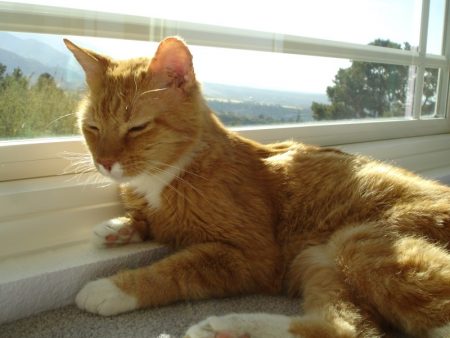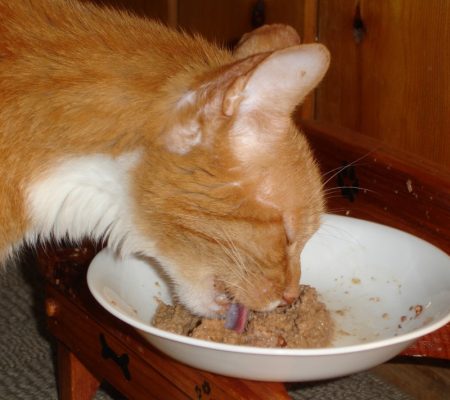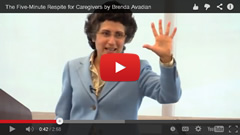Cats are popular these days on Facebook and TikTok. Even dog lovers admit cats’ antics are funny. If we’re willing to be open minded, cats (like dogs) offer us valuable life lessons. I have learned much from my four-legged furry felines; particularly, the last one, diagnosed with FIV and leukemia. He granted me the privilege of serving as his caregiver.
While I’ve written previously about Narenge (“orange” in Armenian), here’s a quick background for those who are just learning about this sweet orange tabby cat.
Background—Adopted by Narenge
In 2003, a family in a suburb of Los Angeles moved and forgot one of their family members—their cat.
Over the months, two of my three remaining female kitties showed little interest in this bloodied and puss-filled suitor who arrived at the patio door almost weekly.
Building Mutual Trust
Initially, I’d slide open the door a little and reach out to clean him with wet paper towels while he stood outside. As the weeks passed, he’d come inside and I’d sit with him right by the sliding glass door. Prepared with a bottle of peroxide, Q-Tips, wet paper towels, and a plastic grocery bag to toss everything in I would tend to his wounds. Even with years of experience caring for cats, the idea that a kitty allowed a stranger to clean dried blood off his wounds and out of his puss-filled ears warmed my heart. While he’d fidget or pull away, he never scratched or bit. Toward the end, he even purred.
To the Veterinarian We Go
It was obvious that this almost-weekly routine needed expert help. I took him to the veterinarian. Two costly blood tests and the diagnosis of FIV (cat’s version of AIDS), the kind doctor suggested putting him down to avoid the spread of FIV to other neighborhood cats. I reasoned, he had already been with other kitties in the neighborhood, including mine who went outside from time to time. He had many opportunities to infect other cats. The vet agreed. So, I scheduled an appointment for him to be broken. (People mistakenly call this getting “fixed”. Fixing means mending, repairing, or restoring. Removing or snipping reproductive organs involves breaking not fixing.)
Adoption Agreement and a Major Change of Scenery
In 2004, I was preparing to move to a five-acre homesteaded property in the Angeles National Forest. If this kitty agreed to be part of the family, he would need to show up on the final day of the move.
Surprisingly, he did.
He welcomed the change of scenery—life in suburbia to the rural foothills. After joining me outside a few times, he fully embraced the indoors. This, after two occasions when a hawk circled overhead while he explored the ground. I knew the risks and always kept an eye on him. But when his body froze and his dilated eyes begged to be protected, I quickly picked him up and held him close. This new home in the forest had assorted visitors, which included bobcats, coyotes, and the occasional bear and mountain lion. Less predatory creatures visited more frequently, including deer, rabbits, squirrels, and quail.
He was the sweetest, kindest, smartest, and most-gentle kitty of the four I had cared for over a 25-year period. And he agreed to let me be his caregiver.
He taught me much about caregiving, even after I cared for my father with Alzheimer’s.
Narenge’s Lessons for Caregivers
Meow your specific request.
The hardest and bravest thing we can do, is to ask for help. This is especially true for caregivers. As Narenge grew more confident in the family, he grew insistent… sometimes, demanding. Like caring for a person with dementia, he didn’t have the words to express what he needed. I often guessed incorrectly. It was heartbreaking.

Assert your “right” to a be taken care of by others.
It takes time for us to get used to asking for help. My father who lived with dementia and eventually was diagnosed with probable Alzheimer’s, didn’t want to be a burden. Caregivers felt the same. They didn’t want to burden their children.
But a cat who successfully navigates his/her way into the hearts of humans and knows where s/he stands, makes it clear that we humans must serve him. So, a demanding meow gets attention, initially, followed by that melt-your-heart earnest look with the largest of pupils.
And that’s the key to asking for help. Receive it with gratitude and appreciation.
Show your appreciation… often.
Narenge would speak to me with a gentle meow (approval?) and follow his meows with loud purring. His gratitude was clearly conveyed. Besides, who can resist a warm soft fur ball that purrs?
Take respites—take care of YOU.
While we tend to the needs of others, we must carve out time for caregiver self-care. We can only postpone so many times before our body sends us a clear message: You need a respite! Next week, guest writer, Stephen Bleeker, addresses this very issue.
After taking care of yourself, you’ll be able to better care for another.
Caregiving brings unexpected twists and turns. It’s always best to fit in caregiver self-care. Without respites, it will be hard to keep up with caregiving. During the last three years of Narenge’s life, he lived with lymphoma of the spleen. In the fall of 2012, his body could no longer fight the ravages of FIV and lymphoma and he crossed Rainbow Bridge.
The original article: https://thecaregiversvoice.com/tcv-humor/how-my-cat-taught-me-to-be-a-better-caregiver/
Life lessons cats teach us that go beyond caregiving:
https://www.catster.com/lifestyle/life-lessons-we-can-learn-from-cats/









Pingback: Caregiving: Managing Stress, Burnout, and Self-Care